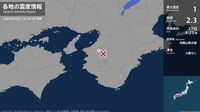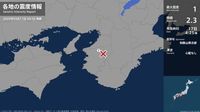On April 17, 2025, at approximately 4:25 AM, a minor earthquake struck Wakayama Prefecture, Japan, registering a maximum seismic intensity of 1. According to the Japan Meteorological Agency (JMA), the epicenter was located in the northern part of the prefecture, with a depth estimated at around 10 kilometers. The earthquake's magnitude was calculated to be 2.3, and there were no tsunami warnings associated with this seismic event.
The city of Kinokawa was the location where the maximum seismic intensity of 1 was recorded. Residents in the area felt the tremors, but reports indicate that no significant damage occurred. The JMA is continuously monitoring the situation and will provide updates as necessary.
Later that morning, at around 5:33 AM, another earthquake occurred in the same region. This second quake was slightly stronger, with a magnitude estimated at 2.7. The JMA reported that the epicenter of this earthquake was also in the northern part of Wakayama Prefecture, specifically at a latitude of 34.2 degrees north and a longitude of 135.3 degrees east. The depth remained consistent at approximately 10 kilometers.
Seismic intensity 1 was recorded in various locations, including Wakayama city and Wakayama Ichibancho. Similar to the first earthquake, there was no concern regarding tsunamis following this event. The JMA has reassured the public that they are monitoring seismic activity closely and will issue alerts if necessary.
Earthquakes are a common occurrence in Japan, a country situated along the Pacific Ring of Fire, known for its high seismic activity. The region experiences numerous tremors each year, ranging from minor shocks that go unnoticed to significant earthquakes that can cause widespread damage.
The Japanese government has invested heavily in earthquake preparedness and response measures. Buildings in earthquake-prone areas are constructed with strict regulations to withstand seismic forces, and the public is educated on safety protocols during an earthquake. This preparedness is crucial, given the country's history of devastating earthquakes, including the Great East Japan Earthquake in 2011, which resulted in significant loss of life and extensive damage.
In the wake of these recent tremors, local authorities in Wakayama have reiterated the importance of being prepared for potential aftershocks. Residents are encouraged to review their emergency plans, ensure they have supplies on hand, and stay informed through official channels.
As of now, there have been no reports of injuries or major structural damage resulting from the earthquakes. However, local officials remain vigilant and are prepared to respond should the situation change. The JMA continues to monitor seismic activity in the region and provides real-time updates to ensure public safety.
The seismic events of April 17 serve as a reminder of Japan's ongoing relationship with its geological environment. While the country has made great strides in earthquake preparedness, the unpredictability of seismic activity means that vigilance is always necessary. Residents are advised to stay alert and to follow any updates from the Japan Meteorological Agency.
In conclusion, while the earthquakes experienced in Wakayama Prefecture were minor and did not result in significant damage or injuries, they highlight the importance of preparedness in a country that frequently faces seismic challenges. The JMA's ongoing monitoring and public communication efforts play a vital role in keeping the community informed and safe.







